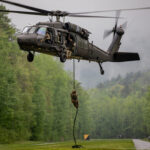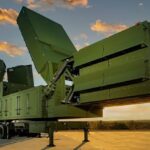US Air Force F-22s form up with F-35s near Eglin AFB in May. A new Mitchell Institute paper claims the fighter force is slipping past the point where upgrades alone can close the gap. (USAF photo)
The Mitchell Institute’s latest policy study reads like a warning flare. Authors – both former three-star generals – say the fighter inventory has fallen so far, and aged so much, that the Air Force can no longer meet its own war-fighting plans. One co-author calls the trend “a collision course with reality.”
He points to a fleet that has shrunk to about 5,400 airframes, down from 8,600 in 1991. Average aircraft age now tops 30 years. In several wings the youngest combat jet on the ramp first flew before its crew chiefs were born.
US Air Force Size and Aging Fleet Challenge Long-Term Warfighting Plans
Mission-capable rates track the decline. Service data show an un-weighted average of 69.9 percent in fiscal 2023, down from 71.2 percent the year before. F-15C readiness sank to 33 percent. B-1B availability slipped below 50 percent despite a recent reduction in fleet size designed to free up depot bandwidth.
“We no longer have margin,” warns another retired general in the report. “Lose one squadron to battle damage and the campaign plan folds.”
The paper’s main prescriptions
- Hike annual fighter buys from 72 to 109.
- Prioritize F-35A production inside that total.
- Retain no platform whose cost per flight hour now exceeds new-build options.
- Expand the depot workforce by 15 percent to cut turnaround times.
Fifth-gen advocates frame the F-35 Block 4 upgrade as the hinge point. A new processor brings 25 times more throughput; an updated radar doubles detection range; redesigned racks raise internal missile load to 14. Those changes, they argue, multiply combat power tenfold. Efforts focused on accelerating 5th generation airpower aim to bring both enhanced capability and increased capacity to address readiness gaps.
Air Force Readiness Struggles Amid TR-3 Delays and Maintenance Challenges
Reality keeps resisting. The Block 4 backbone – Tech Refresh 3 (TR-3) – is a year late. The Joint Program Office stopped accepting new jets fitted with TR-3 hardware. Up to 81 fresh F-35s will sit in Fort Worth until software catches up. This delay is consistent with patterns observed in the F-35 program, where efforts to massage flight test results have attempted to smooth the path forward.
That pause matters because even the jets already in service struggle. GAO auditors told Congress only 53 percent of U.S. F-35As could fly one assigned mission on an average day early this year; fewer than a third could perform the full set.
The fighter force gap is not just metal. Pilot inventory closed 2022 short by roughly 1,900. Commercial airlines keep hiring, trainer aircraft keep failing, and the Air Force produced 224 fewer aviators than planned last year.
Maintenance manning is sliding the same way. The same Mitchell paper notes that as legacy jets overstay, maintainers stay chained to old tasks instead of retraining for new systems, hurting both readiness and morale.
Money alone will not fix it. The National Defense Strategy says China is the pacing challenge, yet budgets still buy mixed fleets that sprawl across 32 distinct designs. Sustainment now eats 70 percent of combat-air funding, leaving modernization stretched thin.
Depot data underline the squeeze. The average fighter is in scheduled teardown 19 percent of the year. A-10 wing spar replacements delay those aircraft more than a year, while B-52 re-engine work runs behind because original suppliers vanished.
Examples pile up:
- Only two of every five F-22s met full-mission standards at any point in 2023.
- KC-135 tankers turn 66 this summer, yet still account for two-thirds of aerial refueling taskings.
- The CV-22 tilt-rotor finished the year below 40 percent readiness after gearbox mishaps grounded the fleet.
A second fault line is sustainment cost. Re-winging an A-10 now totals $20 million – more than half of a brand-new F-35A fly-away price. Heavy F-15E overhauls run even higher. Congress keeps funding them because divestment risks local jobs.
Advocates for the Next Generation Air Dominance (NGAD) program insist that a family of systems – manned and unmanned – will reset the curve early next decade. Skeptics counter that NGAD will enter service too late to shore up current gaps.
Pentagon officials walk a narrow path. They cancelled 421 aircraft in the 2024 budget request hoping to recycle savings, but lawmakers restored a third. One senator called the cut list “a retreat that hands China time.”
The F-15EX story hints at how hard choices play out. Just eight aircraft now serve in test roles, yet they clock an 83 percent mission-capable rate. That success tempts Congress to buy more, even though the Air Force argues every extra F-15EX delays stealthier designs.
Tanker fleets tell a similar tale. The KC-46 still struggles with its Remote Vision System, while the KC-135’s high readiness masks an age profile older than most of its crews’ parents.
Other stressors loom: spare-parts inflation, depot tooling obsolescence, and contested logistics once missiles start falling on forward bases.
When auditors asked what would happen in a high-loss scenario, planners conceded the force could absorb only about two-percent attrition before missing war-plan timelines. That answer rattled the Senate Armed Services Committee enough to order a fighter capacity study next year.
US Air Force Fleet and Readiness Under Pressure from Aging Assets and Funding Constraints
Why the curve keeps bending down
- Depot backlogs doubled since 2010.
- Vendor shutdowns erased parts lines for 2,700 components.
- Supply-chain fragility after COVID still cuts engine blade deliveries by 18 percent.
- Recruiting shortfalls leave basic aircraft-maintenance courses 12 percent under-filled.
Each factor compounds the others. A grounded bomber needs replacement parts and trained crews; both are scarce, so the jet waits longer, starving aircrew currency, which drags readiness lower still.
TR-3 delays feed that spiral. With so many jets parked, spare-parts pipelines clog. Lockheed now stores airframes valued at more than $6 billion, and the Air Force pays to keep acceptance teams idle. Program cost estimates for Block 4 rose from $10.6 billion in 2018 to $16.5 billion last fall, and the target completion date slipped from 2025 to 2030.
GAO flagged another risk: even if TR-3 works, Block 4 adds 37 new capabilities that demand 930,000 additional lines of code. Flight-test capacity is already oversubscribed by new bomber and tanker programs.
Reuters later revealed that DoD will resume F-35 deliveries this summer, but will hold back about $7 million per jet until full TR-3 certification – effectively taxing the contractor for its delay.
Taken together, the data describe an Air Force that is too old, too small, and too busy to rest, yet too hollow to fight long. Service leaders must pick between capacity today and capability tomorrow – choices no one likes, but choices the physics of aging airplanes now force.
WHAT’S NEW – US Air Force Fighter Aircraft Inventory 2025 Readiness Crisis
March 2025 finds most of the warnings above confirmed. The latest readiness table leaked during the Air & Space Forces Association symposium shows the fleet averaged just 62 percent mission-capable in fiscal 2024, the worst figure on record. That translates into roughly 1,900 aircraft grounded on any given day – the capacity of ten fighter wings or two entire tanker fleets.
The average aircraft age crept past 31.8 years, and the gap between need and inventory widened as retirements again outpaced deliveries. The F-15C is now gone from Kadena, replaced by rotating squadrons that strain both pilot availability and maintenance manning, confirming fears voiced in 2023.
F-35 deliveries restarted in July 2024, but every jet still lacks full-up TR-3 software. Crews can train, yet they cannot employ the promised weapons load or new electronic-attack modes. Program officials expect the first combat-coded software drop no earlier than December 2025. Congress continues to withhold a slice of each unit payment until that milestone closes.
Projected Fighter Inventory Decline and Sustainment Challenges in US Air Force 2025
A fresh Mitchell Institute brief, published in February, cuts through the optimism. To stop the force from shrinking any further, it says, the Air Force must buy at least 74 F-35As and 24 F-15EXs every year for five straight budgets, plus fund depot line expansions that double component repair throughput.
Readiness data inside that same study underline the slope:
- F-22 mission-capable rate slid to 40.2 percent.
- KC-46 fell four points to 61 percent while awaiting a redesigned vision suite.
- CV-22 availability collapsed to 30 percent after another clutch failure grounded the Osprey force for three months.
Air Force leaders concede the pilot gap still hovers near 1,800. Training pipelines remain jammed because T-38 and T-6 fleets post mission-capable rates in the low-50s. Spare-parts vendors for those jets closed years ago, and new T-7A deliveries will not start until 2026.
US Air Force Size and Readiness Outlook Amid Legacy Fleet Retirements and Budget Battles
Chief of Staff Gen. David Allvin now warns openly that the fleet “is eating its seed corn.” He told lawmakers the service has “run out of tricks” to mask shortages with longer hours and creative cannibalization – comments that echo, almost word for word, the generals who wrote the 2023 Mitchell paper.
The fiscal 2026 budget request tries to break the pattern by retiring 250 more legacy aircraft and plowing the savings into depot facilities and spare-parts kits. House appropriators, however, have already signaled resistance, arguing that divestments reveal weakness to China. The resulting stalemate keeps the curve bending down.
The story’s bottom line has not changed: the Air Force flies the oldest, smallest fleet in its history at the moment peer threats climb fastest. Unless Congress, industry, and the service align on fewer types, faster buys, and deeper sustainment reform, the math will keep eroding combat power – until events, not studies, settle the argument.
REFERENCE SOURCES
- https://www.reuters.com/business/aerospace-defense/f-35-jet-deliveries-resume-soon-with-truncated-software-upgrade-2024-07-11/
- https://www.pogo.org/newsletters/the-bunker/the-bunker-the-pentagons-more-more-more-refrain
- https://www.mitchellaerospacepower.org/app/uploads/2023/06/Accelerating_Fifth_Generation_Airpower_Policy_Paper_43-FINAL.pdf
- https://www.airandspaceforces.com/air-force-mission-capable-rates-2023/
- https://www.defensenews.com/air/2025/03/06/air-force-aircraft-readiness-plunges-to-new-low-alarming-chief/
- https://www.airandspaceforces.com/air-force-mission-capable-rates-fiscal-2024/
- https://www.airandspaceforces.com/air-force-boost-pilot-retention/
- https://www.airandspaceforces.com/article/accelerating-fifth-gen-airpower/



